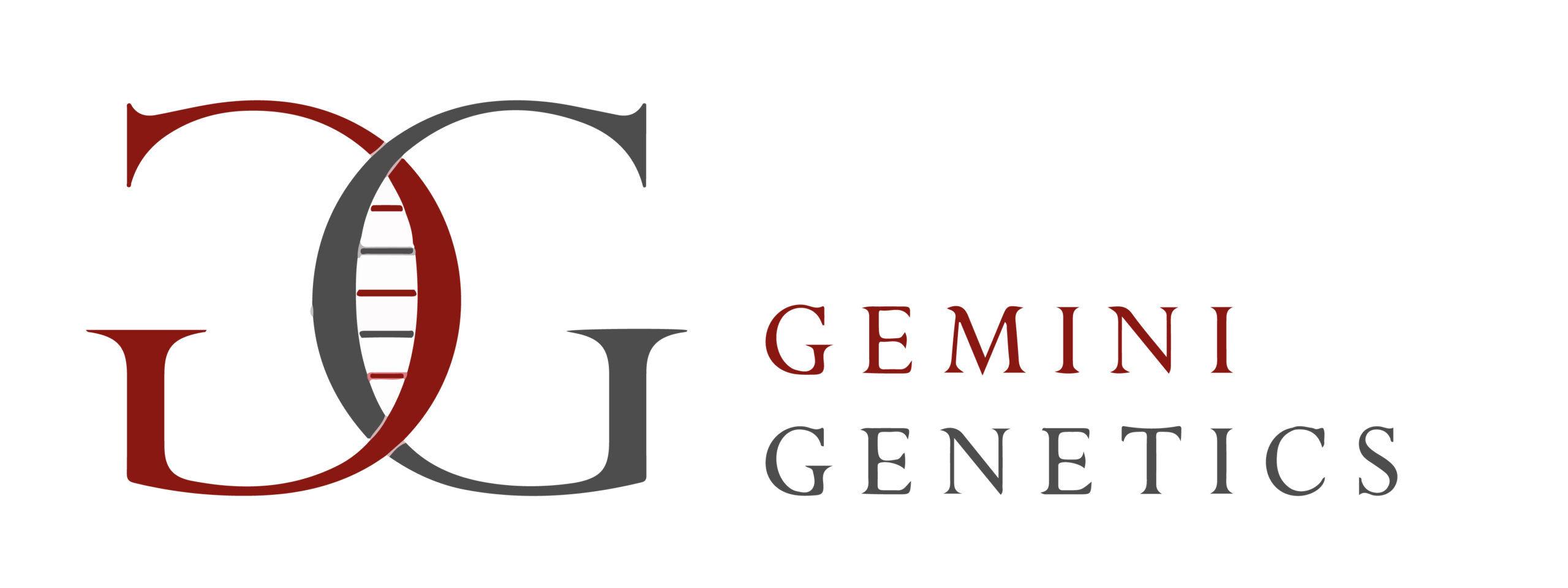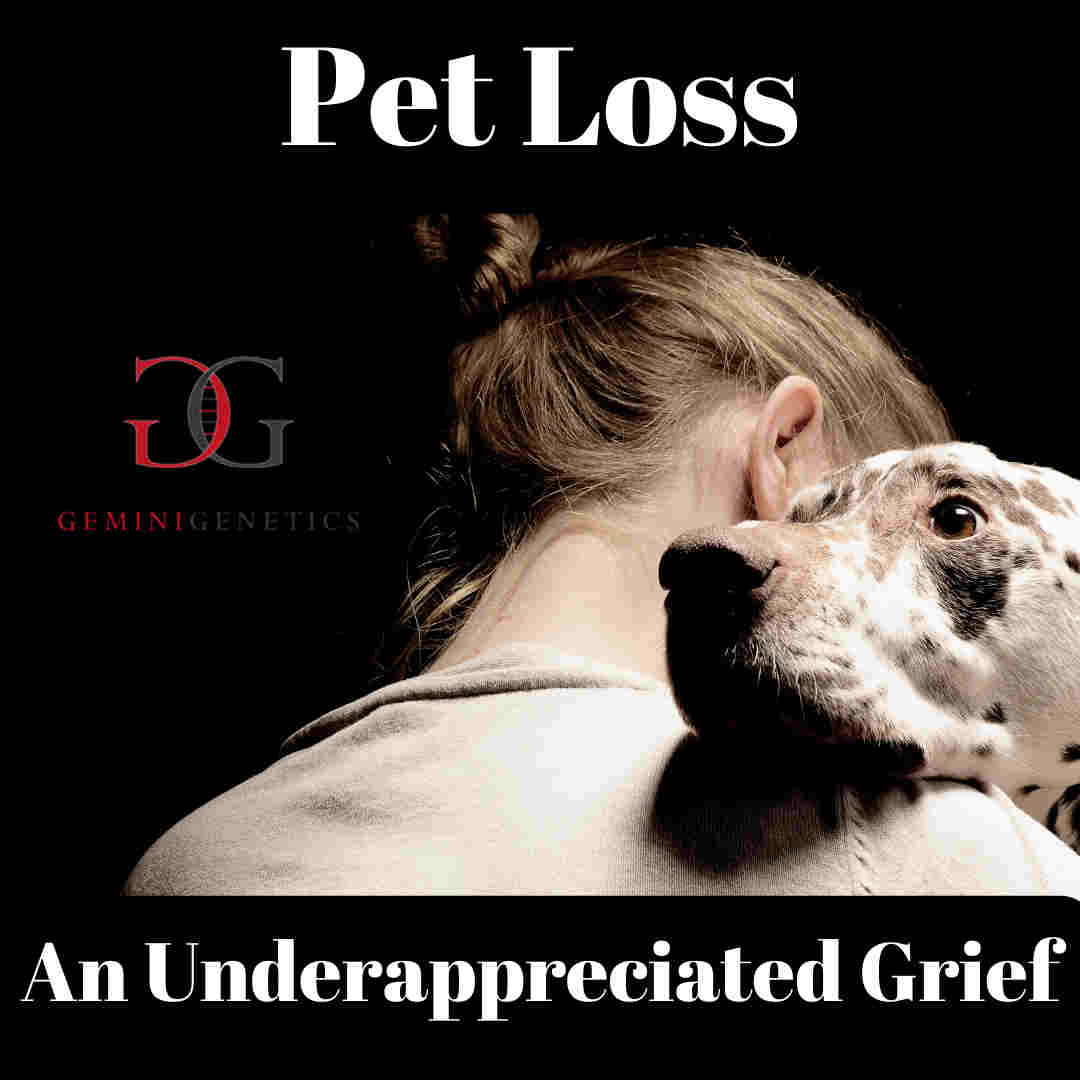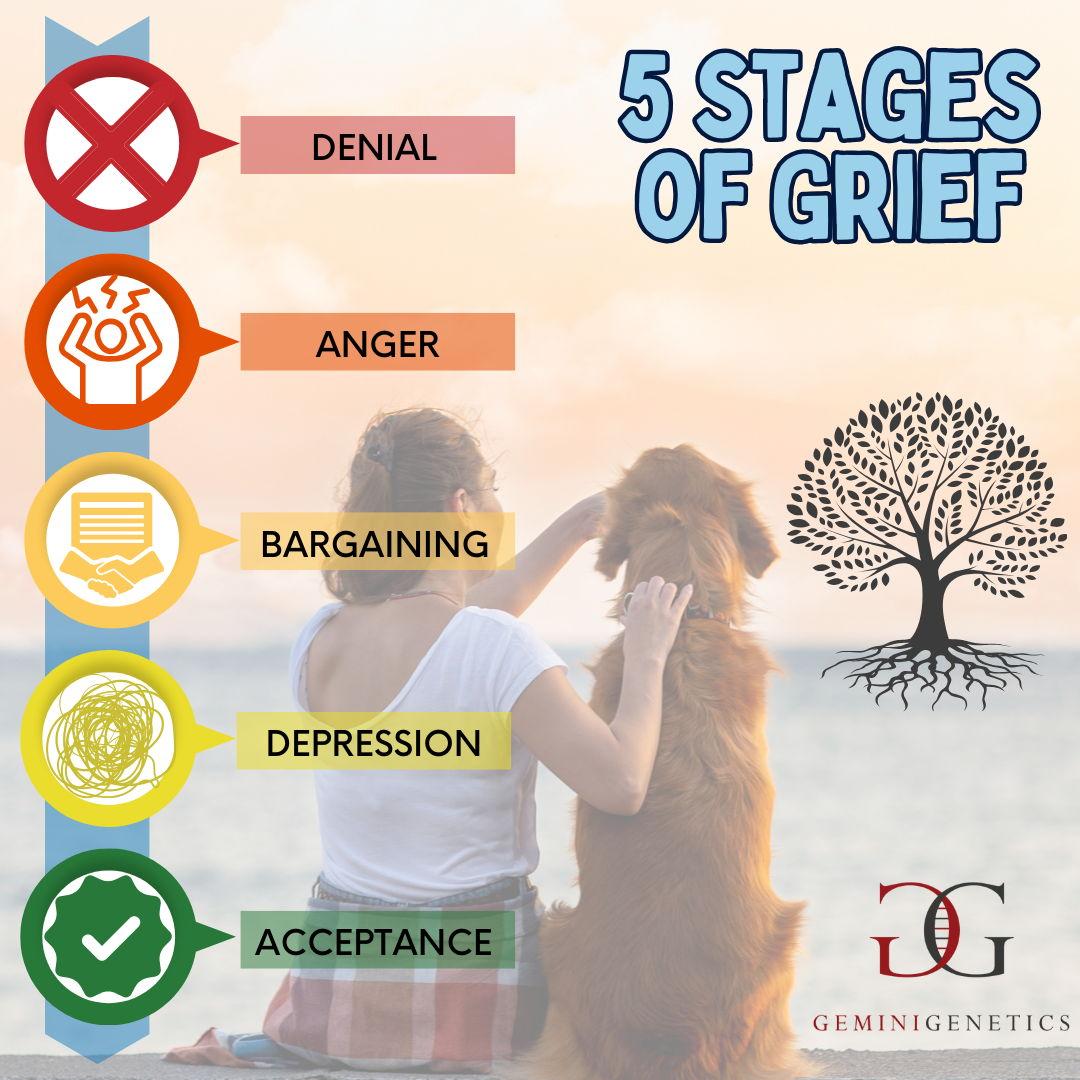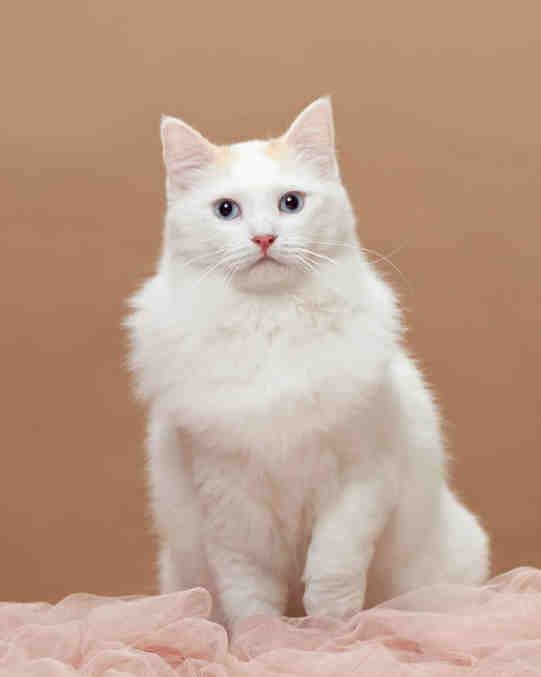Pet Loss. An Underappreciated Grief? At Gemini Genetics, we fully understand the grief that losing…
What Is Pet Cloning?
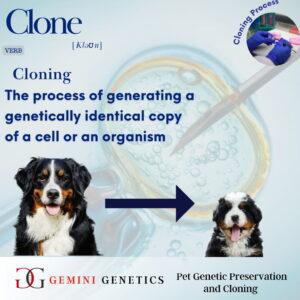
What Is Pet Cloning?
The word “cloning” refers to a variety of procedures that may be used to create biological copies that are genetically identical to the original. A clone is a copy of a substance that shares the same genetic make-up as the original. Numerous biological components, including genes, cells, tissues, and even complete creatures like sheep, have been cloned by researchers, and now cat, dog and equine cloning is widely and reliably available via international companies such as our partner, ViaGen Pets & Equine.
Is cloning just a man made event?
No! Cloning can in fact occur as a natural phenomenon.
Asexual reproduction is a natural method used by certain plants, bacteria, and single-celled creatures to create genetically identical offspring, i.e. clones. A new organism is created by asexual reproduction using a duplicate of a single cell from the parent organism.
Humans and other mammals may produce natural clones, commonly referred to as identical twins. When a fertilised egg separates into two or more embryos with almost identical DNA, these twins are created. The twins share common genes with their parents, but are genetically identical to each other.
There are also naturally occurring clones among animal populations. Chillingham cattle are a rare and ancient breed of cattle that reside in Chillingham Park, Northumberland, England. They are a unique and isolated population of wild white cattle that have roamed the park for hundreds of years, and have never been domesticated or crossbred with other breeds of cattle. As well as their distinctive white markings and long curved horns, these cattle are special because they are now considered a herd of naturally occurring clones. After being free from human interference and the addition of new cattle for over 1000 years, this UK Native breed are considered so genetically similar that they are in fact, genetic clones of each other. One of the wardens protecting these animals in Chillingham Cattle Park, Denene Crossley, states how “being isolated, they’ve managed to essentially purify their gene pool, to the point where they’re natural clones of each other.”
What Are The Different Types Of Cloning?
There are 5 main types of cloning. These include;
Reproductive Cloning: This is the most known form of cloning and involves creating a genetically identical replica of a whole organism. The cloning of ‘Dolly The Sheep’ in 1996 by the Rosalind Institute in Scotland, UK, is the most recognised example of reproductive cloning. The process of reproductive cloning involves the nucleus of a somatic (body) cell from a donor organism to be cloned being transferred into an egg cell whose nucleus (genetic material) has been removed. The resulting embryo is then implanted into a surrogate mother, resulting in the birth of an animal genetically identical to the body cell donor.
Therapeutic Cloning: Therapeutic cloning refers to the production of embryonic stem cells for medicinal reasons, for example regenerative medicine and tissue replacement. Therapeutic cloning involves the creation of an early-stage embryo (blastocyst) and the removal of stem cells from the developing embryo. The recovered stem cells can then be used in the treatment of diseases and to aid the recovery of injuries.
Molecular Cloning: Molecular cloning refers to the production of multiple copies of a DNA fragment or gene. This is achieved by inserting the target DNA into a vector (e.g. a plasmid) and then inserting the vector loaded with the target DNA into a host organism, e.g. bacteria. The host organism copies the DNA along with its own, producing multiple replicas of the target DNA.
Gene Cloning: Gene cloning refers to the identification and duplication of a single gene or a DNA segment, for the intention of investigating its function or creating a particular protein.
What is Pet Cloning?
Pet cloning is a form of reproductive cloning. Pet cloning is the process where a genetically identical twin is created of your original animal companion. Pet cloning is achieved via use of a skin sample from the pet you want to clone. The DNA within the skin sample is cultured and inserted into a donor egg cell whose nucleus (genetic material) has been removed. An electrical impulse is then applied to the egg cell to stimulate it to become an embryo. The embryo is then allowed to mature in the laboratory for a few days before being transferred to a surrogate mum. The surrogate mum carries the cloned pet for the gestation period and once ready, gives birth to the clone who will be an identical genetic twin to the original pet whose skin sample was used to make the nucleus of the donor egg cell.
Though pet cloning may be considered a relatively new technology, the process of cloning as defined above is first documented in 1885, where Hans Adolf Eduard Driesch demonstrated artificial embryo twinning on a sea-urchin. As the sea urchin is a simplistic organism, Driesch was able to demonstrate that it was possible to separate the two-celled embryos by merely shaking them. These separate cells each could grow on their own individual.
The process of cloning mammals occurred much later due to their more complex make up. First, Steen Willadsen separated a cell from an 8-cell embryo and used a small electric shock to fuse it to an enucleated egg cell. This started dividing, demonstrating a mammal can be cloned through nuclear transfer.
Although there was now a way to clone an embryo, there was no way of cloning an adult animal. Embryotic cells have specific genetic properties that allow them to be ready to activate any gene, however, differentiated adult cells shut down the genes they don’t need for their specific functions. It was determined that in order to clone a somatic cell it would have to be reset back to an embryotic state.
Ian Wilmut and Keith Campbell made history when they discovered that starving a cell of nutrients was an effective way of resetting the adult cell. On July 5th, 1996, the first successful clone of a mammal from a somatic cell was born, Dolly the Sheep. Since then, the cloning technology has been further researched and optimised, to improve the efficiency of the nuclear transfer.
Shortly after the birth of Dolly The Sheep, cloning was banned in the UK, amidst fears of the possibility of human cloning. While the UK because cautious of the technology, other countries seized the opportunity to further develop and improve the techniques and efficiencies of reproductive cloning. The USA in particular has made great strides in optimising reproductive cloning, with Texas based ViaGen Pets & Equine recognised as a world leader in this field of reproductive science.
How Many People Are Cloning Their Pets?
With greater optimisation of cloning, realised applications in animal conservation and the more developed human animal bond, pet cloning is becoming increasingly popular, with not just US pet and equine owners investing in pet cloning, but people worldwide considering cloning their much-loved animal companions, or high performing sport and breeding animals. Since their establishment in 2015, ViaGen Pets & Equine have cloned hundreds of cats, dogs and horses, with the numbers increasing year on year.
At Gemini Genetics, we work with ViaGen Pets & Equine to allow more people to have the opportunity to clone their pet. The first stage of preserving pet DNA for cloning is time critical. At Gemini Genetics, we can provide the time critical genetic preservation and cell culture stages of the pet cloning process. We can then store the preserved samples for future pet cloning, once the owner is ready to progress to that stage. Once the owner is ready to clone their pet, we can safely ship the preserved genetic samples to ViaGen Pets & Equine for them to successfully carry out the cloning of the pet, using their optimised reproductive cloning techniques.
How Much Does Pet Cloning Cost?
While pet cloning in the end stage carries a price tag of $50,000 USD for cats and dogs and $85,000 USD for horses, the initial preservation of DNA for future cloning costs just £500 with Gemini Genetics, meaning people can preserve the chance to clone their pets in the future if fundraising is required. Even just banking DNA for the prospect of future cloning can significantly help bereaved pet owners during pet loss. The banking of DNA in the way that they can clone their pets if they decide to do so in the future can help soften the loss of a much loved animal; it means the door isn’t completely closed on their original animal, and they have the prospect and hope of cloning, should they decide to do so in the future.
Our pet cloning partner ViaGen Pets & Equine also aim to continually improve the efficiency of the pet cloning process, to increase the affordability of the service and allow more people to clone their much loved animal companions.
Do Cloned Pets Look The Same?
Cloned pets have the exact same DNA as the original pet. Pet cloning is simply creating a genetic twin to the original pet who is born later in time! This means cloned pets will share the same characteristics, where those characteristics are genetically founded.
In terms of the appearance, there are some markings that are influenced not only by genetics, but also the environment. The environment in the womb being of most influence and something which cant be replicated exactly to the womb environment that the original animal had. This means that for pets that are not solid colour, some slight differences in the appearance of certain markings can be seen. For pets of solid colour, the virtual same appearance can be expected.
An example of difference in appearance is one of the first cats to be cloned – a cat called CC who was born in 2001. CC had a different coat colour appearance to the donor cat, Rainbow. This is because coat colour in certain breeds of cats and dogs is fluid in expression, and influenced by events that happen in the womb. Which coat colour genes are switched on and which are shut off is a result of a biological process that involves the inactivation of the X chromosome in each cell of the female cat, which has two X chromosomes. The distribution of X inactivation, which appears to be random, influences how the cat’s coat will look. As this event in random, and also happens in the womb, rather than being determined directly by the cats genetics, it can result in some differences in appearance despite the identical genetics between the clone and original.
Despite difference in appearance, CC was a full genetic replica of Rainbow and the closest possible living replica and relative to her. CC went on to be a happy healthy cat and have kittens of her own which continued the legacy of Rainbow.
Have Humans Been Cloned?
Human cloning still seems to be science fiction despite multiple well reported claims. There is no conclusive scientific proof to date that human embryos have been cloned.
South Korean researchers claimed to have successfully cloned a human embryo in 1998, however they later admitted that the operation was stopped when the clone was only a collection of four cells. In 2002, a religious organisation called Clonaid, which belongs to the school of thought that holds that humans were created by extra terrestrials, held a press conference to announce the birth of Eve, a girl they claimed to be the first human to be cloned. However, despite several demands from the scientific community and the media, Clonaid never offered any proof that this or the other 12 human clones it allegedly made actually existed.
A team from Seoul National University in South Korea, lead by Woo-Suk Hwang, claimed to have produced a cloned human embryo in a test tube in an article that was published in the journal Science in 2004. But afterwards, an impartial scientific panel found no evidence to back up the assertion, and in January 2006, Science said that Hwang’s study had been retracted.
Cloning humans and other primates is more challenging than cloning other mammals from a technical standpoint. One explanation is because in primate eggs, two proteins known as spindle proteins that are crucial for cell division are situated very close to the chromosomes. Therefore, the spindle proteins are also removed when the egg’s nucleus is removed to make way for the donor nucleus, preventing cell division. The two spindle proteins in the eggs of other mammals like cats, rabbits, and mice are dispersed throughout the egg. Therefore, the spindle proteins are not lost when the egg’s nucleus is removed. The primate cell can also be harmed by some dyes and the ultraviolet light used to extract the egg’s nucleus, which will stop it from expanding.
What Are The Applications Of Pet & Animal Cloning?
Pet cloning enables owners to create a genetic twin to their original animal. In doing so, it enables owners to create the closest living replica to their original animal. This can provide comfort and a living legacy to a much loved pet. Even though some argue that clones do not always look the same, this should not discredit the benefit of the technology for a much loved animal companion. Many of our cats and dogs are neutered so its not possible to breed a son or daughter from them, to maintain their legacy and connection within the family. With this in mind, cloning is the only way in which an owner can create a lasting memory and connection to their original animal. For some people, when their pet passes away, rehoming another pet may be what they choose after the grieving process is complete. For others, they want to keep a connection to their original pet. And without any sons or daughters to do so, cloning is the route they choose.
In addition to pet cloning, reproductive cloning can have applications and benefits for medicine and agriculture, when applied to farm animals.
An example is the work of the same group of scientists who cloned Dolly The Sheep. They have cloned other sheep that have a special gene which enables them to produce milk that contains a protein which helps with human blood clotting. The aim is for the protein to be purified from the milk, enabling a more organic treatment for human blood clotting disorders versus synthetically manufactured drugs.
In the USA, cloned farm animals are permitted in the food producing industries. This has resulted in a growing proportion of the UK meat supply being from cloned farm animals. The benefit here is that once the farmers have an animal with their ideal set of production traits, e.g. ideal milk yield, body muscling etc, they can clone the animal to produces clones that have these exact same traits. This allows for the production of farm animals with more predictable high quality traits versus breeding with sperm and egg, where even with elite parents, variation in offspring can be seen due to the random combination of genetics at conception.
The last, but by no means least, application of reproductive cloning is for wild and endangered species conservation. And this is a field where both Gemini Genetics and our partner cloning company, ViaGen Pets and Equine, work and support, in addition to pet & equine cloning. By banking wild and endangered animal DNA in a way that the animals can be cloned, means that these species have a regenerative safety net of genetics for the future. Also, a common issue in small populations of animals such as rare breeds and rare and endangered species is inbreeding. When population numbers decline, inbreeding inevitably increases as the numbers available to mate with declines. Inbreeding has negative effects on a population once it reaches a certain level, with such effects a threat to long term survival. Cloning can enable the genetic replication of individuals that are least related to the current population, and so enable the introduction of genetic diversity that can be crucial to the breed and species long term survival. This is the reason behind the cloning of 2 przewalski horse and Elizabeth Ann, the world’s first cloned black footed ferret.
At Gemini Genetics, we support a sister charity with their fight against biodiversity loss. We help our sister charity bank genetics from wild and endangered animals in a way that those genetics can be bought back to life if and when needed for conservation. So while we help owners clone their much loved pets, we are also doing our bit for the environment and helping to save animals from extinction. You can find out more about cloning and saving species via this fantastic TED talk https://www.ted.com/talks/ryan_phelan_the_intended_consequences_of_helping_nature_thrive
To learn more about pet cloning, including how to start the process, please visit our website, or contact us, for skin sample taking instructions. https://www.geminigenetics.com/contact-us/
